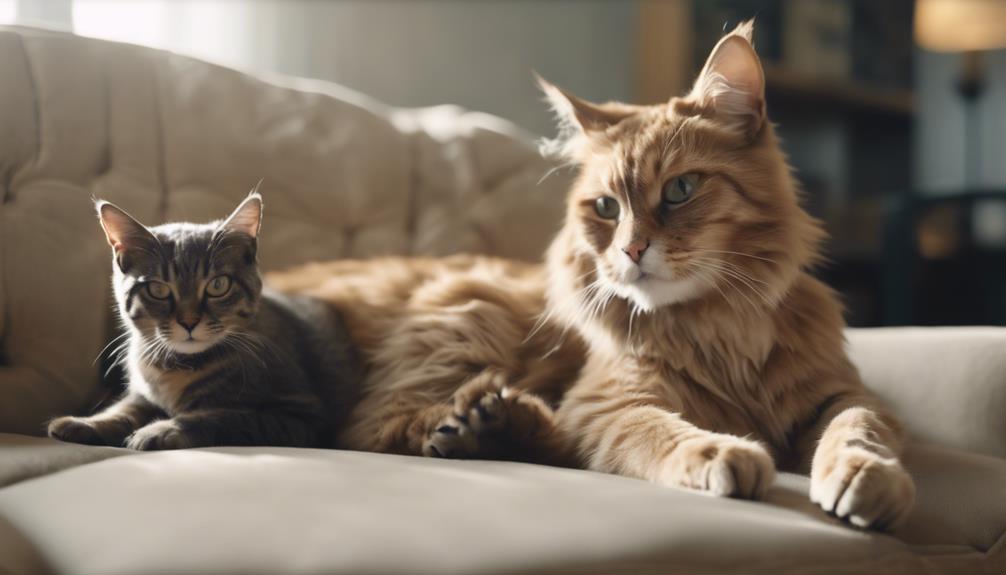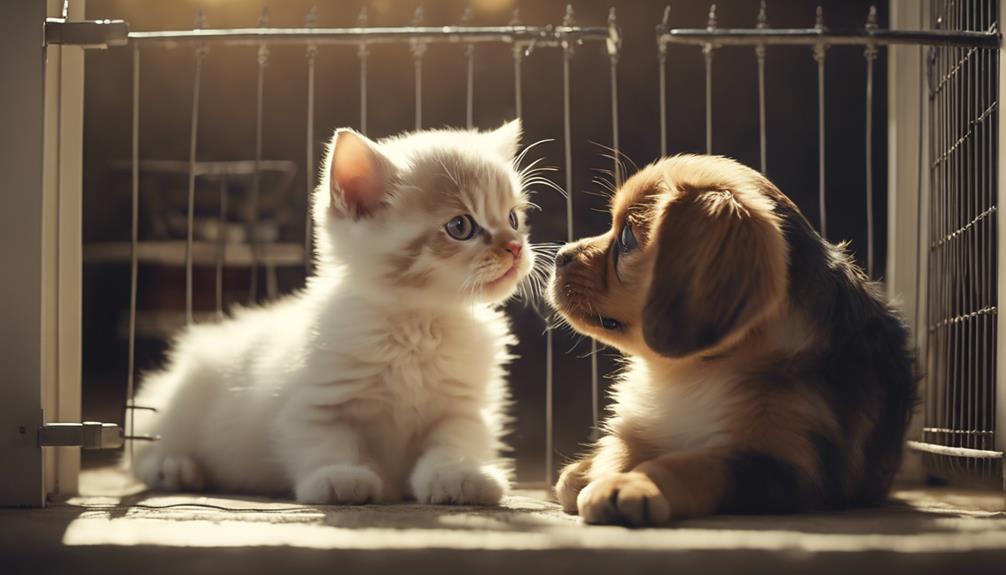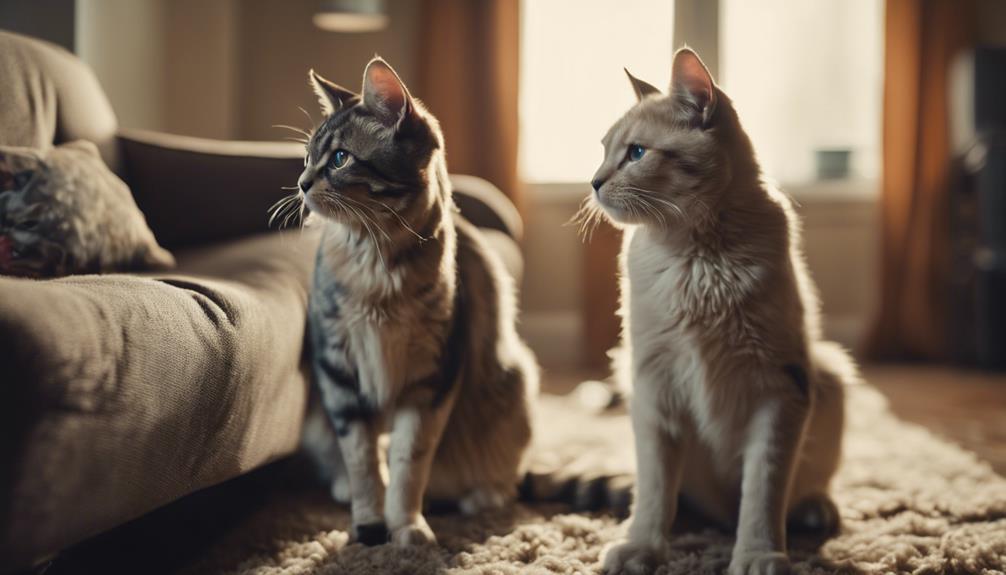Do Older Cats Socialize Well With Puppies?

Older cats may feel anxious or threatened by the presence of a new puppy in their territory. They might need time and space to adjust to the new situation, and it's essential to monitor their interactions carefully.
Introducing the animals gradually and providing separate spaces for each pet can help reduce stress and prevent conflicts. It's also important to ensure that both pets have their own food, water, and resting areas to avoid competition.
With patience and proper supervision, older cats and puppies can learn to coexist peacefully and even form close bonds.
Age Difference and Social Dynamics
When older cats socialize with puppies, their age difference often influences the social dynamics between the two groups. The socialization dynamics between older cats and puppies can be intriguing to observe. The age gap between them can lead to unique communication patterns and behavioral changes. Older cats may initially display signs of reluctance or even annoyance towards the energetic demeanor of puppies. On the other hand, puppies might exhibit high levels of curiosity and playfulness when interacting with older cats. Understanding these dynamics is crucial when introducing these animals to each other.
The age difference can impact how they communicate and interact. Older cats may set boundaries and communicate through subtle cues, such as body language and vocalizations, to establish their authority. Puppies, on the other hand, might misinterpret these signals or display excitable behavior, which could lead to misunderstandings. It's essential to monitor their interactions carefully to ensure a harmonious relationship between the older cats and puppies. By recognizing and respecting each other's boundaries, these animals can develop positive social dynamics despite their age disparity.
Behavioral Patterns and Communication

How do older cats and puppies exhibit distinct behavioral patterns in their communication interactions? When observing their interactions, it becomes evident that both species rely heavily on nonverbal cues and body language to communicate effectively.
Older cats often use subtle body movements and vocalizations to convey their emotions and intentions to puppies. For example, a cat may flick its tail nervously when feeling uneasy around a playful puppy, signaling the need for space. On the other hand, a relaxed posture and gentle purring can indicate contentment and a willingness to engage in social interactions.
Puppies, on the other hand, tend to display more overt signals of excitement or submission towards older cats. They may wag their tails enthusiastically when approaching a cat in a friendly manner or cower down with ears flattened against their heads to show deference and respect.
Understanding these behavioral patterns and nonverbal cues is crucial when introducing older cats to puppies to ensure a harmonious and respectful relationship between the two animals.
Environmental Considerations for Integration

When integrating older cats with puppies, it's crucial to consider the age and temperament compatibility between the animals.
Slow and supervised introductions help in minimizing stress and ensuring a smoother transition for both pets.
Creating a harmonious environment is key to successful socialization between older cats and puppies.
Age and Temperament Compatibility
Considering the age and temperament compatibility of older cats and puppies is crucial for a successful integration process. Conducting temperament assessments and compatibility testing can provide valuable insights into whether the pets are likely to get along well.
Socialization strategies and behavior adjustment techniques can then be tailored based on these assessments to facilitate a harmonious relationship between the older cat and the puppy. It's important to remember that each animal has its unique personality and preferences.
Slow and Supervised Introductions
To ensure a smooth integration between older cats and puppies, gradual and supervised introductions in carefully controlled environments are essential. When introducing older cats to puppies, it's vital to consider their comfort and safety. Here are some tips for successful integration:
- Gradual Acclimation: Allow the older cat and the puppy to become familiar with each other's scents before physical introductions.
- Supervised Interactions: Always supervise their interactions closely to prevent any aggressive behavior.
- Safe Spaces: Provide separate safe spaces for both the cat and the puppy to retreat to when needed.
- Positive Reinforcement: Reward good behavior from both the cat and the puppy to encourage positive interactions and create a harmonious environment for them to socialize.
Health and Safety Precautions to Take

When introducing older cats to puppies, it's crucial to consider age-related health concerns and take necessary precautions. Proper introduction techniques, such as gradual introductions and supervised interactions, can help minimize stress and ensure safety for both pets.
Being mindful of the different needs and behaviors of cats and puppies can help create a harmonious environment for socialization.
Age-Related Health Concerns
As cats age, it's crucial to be mindful of potential health concerns and take appropriate safety precautions to ensure their well-being. Here are some essential considerations:
- Nutritional Needs: Older cats may require specialized diets that cater to their changing nutritional requirements, such as lower calorie content to prevent obesity or specific nutrients for joint health.
- Mobility Issues: Aging cats can experience arthritis or reduced mobility; provide easy access to litter boxes, resting spots, and ensure their environment is safe and accessible.
- Regular Vet Check-ups: Schedule frequent veterinary visits to monitor your cat's health, address any issues promptly, and adjust care as needed.
- Comfortable Environment: Create a comfortable living space with cozy bedding, warm areas, and places for solitude to cater to your aging cat's needs.
Proper Introduction Techniques
As older cats adapt to potential age-related health concerns, ensuring proper introduction techniques when socializing with puppies is crucial for maintaining their well-being and safety.
When introducing an older cat to a puppy, pay close attention to their body language. Signs of stress, fear, or aggression should be addressed immediately by separating the animals and giving them space.
Positive reinforcement is key during introductions; reward calm behavior from both the cat and the puppy with treats or gentle praise to create positive associations.
Slow and supervised introductions in a neutral space can help prevent conflicts and allow the animals to become familiar with each other's scents and presence gradually.
Training Techniques for Harmony

Implementing effective training techniques can foster harmony between older cats and puppies when socializing. Positive reinforcement and consistent boundaries play crucial roles in shaping their interactions. Here are four key strategies to promote a peaceful coexistence between older cats and puppies:
- Reward Good Behavior: Use treats or verbal praise to reinforce positive interactions between the cat and the puppy. This can help them associate good behavior with pleasant outcomes.
- Establish Safe Spaces: Create separate areas where the cat and puppy can retreat to when they need time alone. This ensures that both animals have a sanctuary to feel secure.
- Supervise Interactions: Monitor their interactions closely, especially during the initial stages of socialization. Intervene if necessary to prevent any potential conflicts and ensure a safe environment for both pets.
- Consistency is Key: Maintain consistent schedules for feeding, playtime, and training. Predictability can help reduce stress and anxiety for both the cat and the puppy, leading to a more harmonious relationship.
Common Challenges and Solutions

To navigate the process of socializing older cats with puppies successfully, addressing common challenges and implementing effective solutions is essential. When introducing a new puppy to an older cat, there can be various behavioral challenges that arise. Understanding these challenges and having bonding strategies in place can help create a harmonious environment for both pets. Here is a breakdown of common challenges and solutions:
| Common Challenges | Solutions |
|---|---|
| Different Energy Levels | Gradually introduce them and provide separate resting spaces. |
| Communication Barrier | Use positive reinforcement and consistent training methods. |
| Territory Issues | Allow each pet to have their safe space and supervise interactions. |
| Aggressive Behavior | Seek professional help if needed and never punish the pets. |
| Unequal Attention | Ensure each pet receives individual attention and affection. |
Building a Strong Bond Over Time

Building a strong bond over time between older cats and puppies requires patience, consistency, and understanding of their individual personalities and needs. Establishing a harmonious relationship between the two pets can be a rewarding experience, but it requires deliberate effort and time investment.
Here are some key strategies for fostering a strong bond between older cats and puppies:
- Trust building through a gradual approach: Allow the older cat and puppy to interact at their own pace. Start with short, supervised sessions and gradually increase the time they spend together to build trust and comfort.
- Mutual respect and patience are needed: Both animals may have different communication styles and boundaries. Encourage positive interactions and intervene if any signs of aggression or discomfort arise.
- Provide separate safe spaces: Ensure each pet has a designated area where they can retreat to feel safe and secure when needed.
- Consistent positive reinforcement: Reward good behavior with treats and praise to reinforce positive interactions and encourage bonding over time.
Frequently Asked Questions
Can Older Cats and Puppies Ever Become Best Friends and Play Together Like Siblings?
When introducing a puppy to an older cat, training methods and playtime routines are crucial. It's essential to supervise their interactions, create safe spaces for both pets, and gradually allow them to get acquainted to foster a positive relationship.
How Can I Prevent Jealousy or Aggression Between My Older Cat and New Puppy?
To prevent jealousy or aggression between an older cat and new puppy, focus on managing boundaries and building trust. Slow introductions, positive reinforcement, and separate feeding areas can help create a harmonious environment for both pets.
What Are Some Signs That My Older Cat Is Feeling Overwhelmed or Stressed by the Presence of a New Puppy?
When a new puppy enters the home, older cats may exhibit signs of stress or feeling overwhelmed. They might communicate this through subtle changes in body language like flattened ears or dilated pupils. Providing stress management tools and safe spaces can help them cope.
Are There Specific Activities or Games I Can Do With My Older Cat and Puppy to Help Them Bond and Socialize Better?
To help older cats and puppies bond, consider training techniques like clicker training for positive reinforcement. Introducing slowly and supervising interactions can ease stress. Engage in bonding activities like gentle play sessions to foster a harmonious relationship.
How Long Does It Typically Take for Older Cats and Puppies to Adjust to Each Other and Establish a Harmonious Relationship?
Introducing slowly is crucial when bringing older cats and puppies together. Setting boundaries helps establish a harmonious relationship. Typically, it takes some time for them to adjust, but with patience and positive reinforcement, they can form a strong bond.











